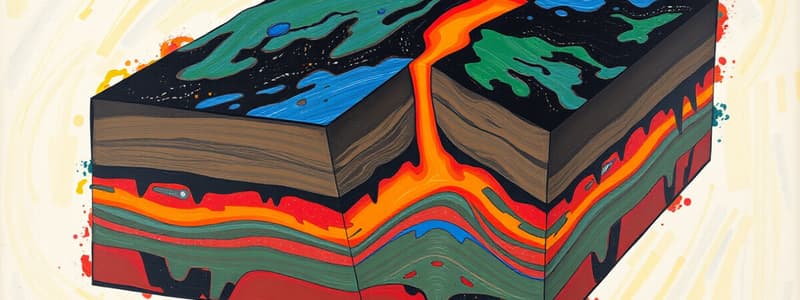Podcast
Questions and Answers
What triggers volcanic activity in subduction zones?
What triggers volcanic activity in subduction zones?
- The melting of oceanic crust due to heat from the mantle
- The uplift of land masses
- The collision of two continental plates
- Water released from the subducting slab of oceanic lithosphere (correct)
Which feature characterizes volcanic island arcs?
Which feature characterizes volcanic island arcs?
- They consist of a chain of volcanic structures emerging from the ocean floor (correct)
- They are created by the collision of two continental slabs
- They are typically formed on continental platforms
- They are situated at the center of large tectonic plates
Which islands are formed by the subduction of the Pacific plate beneath the North American plate?
Which islands are formed by the subduction of the Pacific plate beneath the North American plate?
- Mariana Islands
- Lesser Antilles
- Tonga Islands
- Aleutian Islands (correct)
What phenomenon occurs when oceanic lithosphere subducts beneath continental crust?
What phenomenon occurs when oceanic lithosphere subducts beneath continental crust?
How far are island arcs generally located from a deep-ocean trench?
How far are island arcs generally located from a deep-ocean trench?
Which volcanic island arc is known for the eruption of Mount Pelée in 1902?
Which volcanic island arc is known for the eruption of Mount Pelée in 1902?
At what approximate depth does the mantle wedge begin to melt due to the introduction of water from the descending oceanic plate?
At what approximate depth does the mantle wedge begin to melt due to the introduction of water from the descending oceanic plate?
What is the typical thickness of the oceanic crust underlying most island arcs?
What is the typical thickness of the oceanic crust underlying most island arcs?
How does the presence of water affect the melting of mantle rock in subduction zones?
How does the presence of water affect the melting of mantle rock in subduction zones?
What is the primary cause of magma generation in subduction zones?
What is the primary cause of magma generation in subduction zones?
Which factors contribute to the complexity of some island arcs?
Which factors contribute to the complexity of some island arcs?
What term describes mountain systems formed by volcanic activity associated with subduction?
What term describes mountain systems formed by volcanic activity associated with subduction?
Which of the following is NOT a volcanic island arc?
Which of the following is NOT a volcanic island arc?
Which of the following is NOT a feature associated with the subduction of oceanic lithosphere?
Which of the following is NOT a feature associated with the subduction of oceanic lithosphere?
Which of the following volcanic formations is NOT part of the Cascade Range?
Which of the following volcanic formations is NOT part of the Cascade Range?
What happens to most of the magma generated during the subduction process?
What happens to most of the magma generated during the subduction process?
Flashcards are hidden until you start studying
Study Notes
Subduction and Mantle Melting
- Continental crust remains "floating" when it converges with oceanic lithosphere, causing the denser oceanic slab to sink into the mantle.
- The descending oceanic plate triggers melting in the mantle wedge above due to the release of water from hydrated minerals.
- At depths of around 100 kilometers (60 miles), the temperature is high enough for water to reduce melting temperatures of rocks, allowing for partial melting to occur.
Volcanic Arcs and Mountain Formation
- The Cascade Range is formed by the subduction of the Juan de Fuca plate beneath the North American plate, creating a continental volcanic arc.
- Mount Hood is one of several composite volcanoes in the Cascade Range, illustrating this volcanic activity.
- Molten rock generated through subduction may rise towards the surface, leading to volcanic eruptions, or solidify at depth, thickening the crust.
Andes and Other Continental Volcanic Arcs
- The Andean mountain range is a result of molten rock generated by the subduction of the Nazca plate beneath the South American continent.
- Continental volcanic arcs like the Andes and Cascade Range are characterized by active volcanic activity associated with subduction.
Oceanic-Oceanic Convergent Boundaries
- Oceanic-oceanic convergent boundaries initiate volcanic activity similarly to oceanic-continental margins due to descending slabs.
- Volcanic activity here results in the formation of volcanic island arcs, created by the ascent of magma from subducting oceanic lithosphere.
Volcanic Island Arcs
- The Aleutian Islands form a volcanic island arc from the subduction of the Pacific plate beneath the North American plate.
- Island arcs are typically found 120 to 360 kilometers (75 to 225 miles) from deep-ocean trenches and consist of chains of volcanic islands.
- Examples include the Aleutian, Mariana, and Tonga Islands, mostly located in the western Pacific, with the lesser known arcs in the Atlantic including the Lesser Antilles and the Sandwich Islands.
Lesser Antilles and Historical Volcanic Activity
- The Lesser Antilles resulted from the subduction of the Atlantic seafloor beneath the Caribbean plate; features the Virgin Islands and Montserrat.
- Mount Pelée's eruption in 1902 destroyed St. Pierre, killing approximately 28,000 people, highlighting the risks associated with volcanic activity in island arcs.
Structure and Composition of Island Arcs
- Island arcs are simple structures made up of numerous volcanic cones sitting on thin oceanic crust, generally less than 20 kilometers (12 miles) thick.
- Some island arcs, like those in Japan and Indonesia, may have complex structures with thicker, highly deformed crust reaching up to 35 kilometers (22 miles).
- Many island arcs are formed from material created by earlier subduction episodes or frayed pieces of continental crust.
Types of Convergent Boundaries
- Convergent boundaries can lead to one landmass colliding with another due to the subduction of the intervening seafloor.
- Oceanic lithosphere is denser than continental lithosphere, influencing the dynamics of these tectonic interactions.
Studying That Suits You
Use AI to generate personalized quizzes and flashcards to suit your learning preferences.




